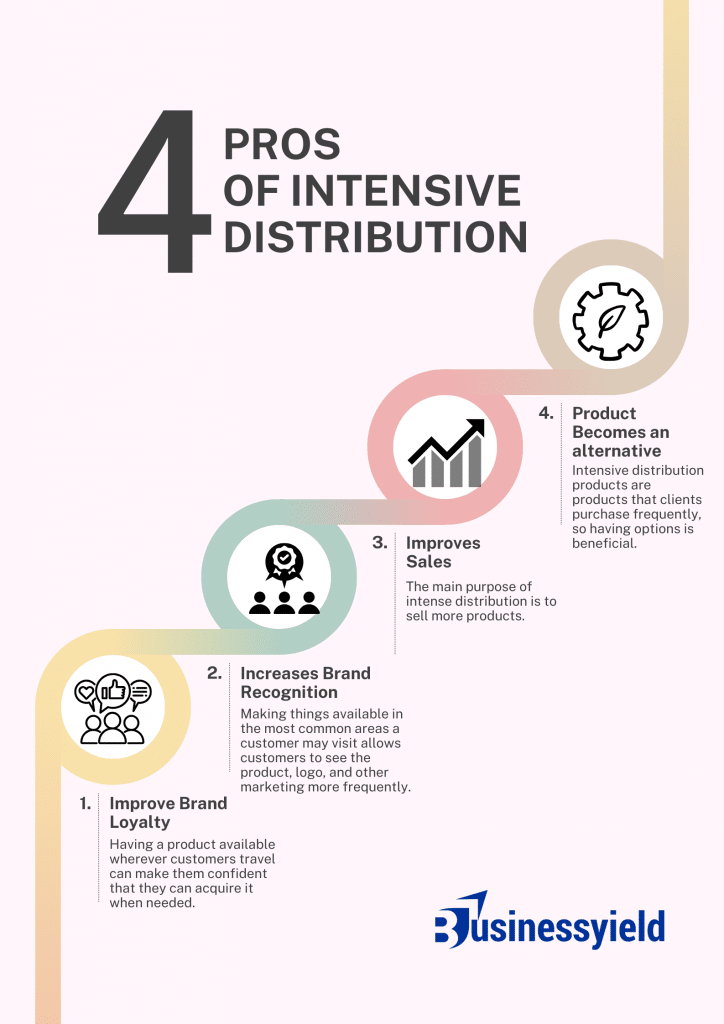As a business writer, I’ve collaborated with clients from several industries, each presenting unique marketing challenges. One experience that left a lasting impression involved a rapidly growing consumer packaged goods company grappling with distribution woes.
During our initial consultation, the company’s marketing director lamented, “Our product is flying off the shelves at major retailers, but we’re constantly out of stock at smaller mom-and-pop stores. It’s like we’re missing out on a huge chunk of the market.” Their frustration was visible, and they considered an intensive distribution strategy a potential solution.
This situation highlighted the importance of understanding intensive distribution – a marketing approach that aims to make a product or service as widely available as possible through multiple channels. By pursuing this strategy, businesses can increase reach, boost sales, and gain a competitive edge in crowded markets.
But, I know that intensive distribution is not a one-size-fits-all solution. It has its advantages and disadvantages, and it may not be the right fit for every business or product. So, in this article, I will provide an in-depth overview of intensive distribution strategy, exploring its benefits and potential pitfalls, as well as real-world examples of companies that have successfully implemented this approach across various sectors.
Key Points
- One of the primary downsides of intensive distribution is losing control over your goods.
- When a company distributes its brand through only one or two large outlets that deal only with it rather than all rival brands, this is referred to as an exclusive distribution strategy.
- Intensive distribution may also have certain downsides. Many involve the logistics required to develop and distribute products to as many retailers as feasible.
What is Intensive Distribution?
As the word implies, intensive distribution is a marketing technique that aims to make a product available in as many retail locations as feasible. Its goal is to make the product more accessible and convenient for customers, increasing sales and market share. This method is frequently employed for fast-moving consumer goods.
Strategy for Intensive Distribution
The ultimate goal of an intensive distribution strategy is to increase volume and visibility. It’s the marketing equivalent of ‘Go big or go home.’ This strategy distributes your products across as many channels as possible to reach the greatest number of clients.
Of course, to accomplish this, you’ll require logistical support services that can keep up with your mass manufacturing efforts.
As a marketing strategy, your main benefits are demonstrated in the following areas:
#1. Complete Market Coverage
Someone will notice when you place your merchandise in front of as many people as possible. Major soft drink firms have made it their mission to be available wherever their products are needed.
For example, when designing a business plan, I encourage my clients to create room for mass products. By outnumbering the competition by a large margin, you drive your other key advantages.
#2. Increased Sales Opportunities
Customers are more likely to purchase if your product is sold in multiple locations and through multiple methods.
Of course, having a good product helps. However, because your product is generally available, it will likely appear sooner than later so that individuals can purchase it themselves.
#3. Maintaining Product Quality and Consistency
This is the major aspect you need to consider. One of the primary downsides of intensive distribution is losing control over your goods. Your brand is most likely dispersed across multiple mediums, each with its unique approach.
The more production sites you have, the more likely anomalies may occur, especially if management is distributed among multiple local logistics providers.
#4. Brand Recognition and Awareness
Wide distribution improves brand visibility, making recognition easier. For example, a consumer is more likely to know a brand of lotion that appears in every grocery aisle.
Such products grow known to potential clients to the point where selecting and purchasing is automatic. People like to buy what they are familiar with, especially if someone recommends it.
#5. Keep Track of a Complex Supply Chain
The fact remains that the more points of sale you have, the more diligent you must be with your supply chain management. It’s not just about the deliveries.
Investing in a skilled logistics provider will ensure your strategy reaches its full potential. Ultimately, you’ll have many things to offer but need a way to deliver them to your target market.
Types of Distributions
Distribution types include intensive, selective, and exclusive.
It represents the marketer’s chosen level of international availability for a specific product; the level of intensity will be determined by factors such as production capacity, target market size, pricing, promotion policies, and the amount of product service required by the end user.
There are three broad choices:
#1. Intensive Distribution
As I mentioned earlier, this strategy utilizes all available outlets to ensure market penetration. Many products’ total sales are directly related to the number of outlets used (e.g., cigarettes, beer). Intensive distribution is usually required when buyers can choose from various acceptable brands. In other words, a client will select another if a particular brand is unavailable.
This alternative considers all conceivable distribution channels for the product. This is especially important for products like soft drinks, where distribution is a critical success component. Soft drink companies distribute their brands across places to ensure easy customer access.
#2. Selective Distribution
Selective distribution is a process where producers market their products using limited outlets in a geographic area. This technique allows the producer to select the most relevant or best-performing sources and spend effort on them (for example, through training). Selective distribution works best when customers are willing to “shop around”—that is, they prefer a specific brand or price and will seek out the stores that supply it.
#3. Exclusive Distribution
Exclusive distribution is selective distribution in which a single wholesaler, retailer, or distributor serves a specific geographic area. When a company distributes its brand through only one or two large outlets that deal only with it rather than all rival brands, this is referred to as an exclusive distribution strategy. This is a frequent distribution method for items and brands that want to project a high-end image.
Intensive Distribution Checklist.pdf
Pros and Cons of Intensive Distribution
Pros of Intensive Distribution

Intensive distribution can have numerous benefits for a corporation. These advantages mostly include increasing customer relationships with a product and its benefits. Intensive distribution has several common advantages, including:
#1. It Helps Improve Brand Loyalty
Having a product available wherever customers travel can make them confident that they can acquire it when needed. This dependability might improve customers’ likelihood of repeat purchases when they need or want a product. Brand loyalty also helps to create relationships with customers, allowing items to become a part of their everyday lives and routines.
#2. Increases Brand Recognition
Making things available in the most common areas a customer may visit allows customers to see the product, logo, and other marketing more frequently. This repetition can assist customers in understanding the product and its intended purpose. Increasing brand awareness in this manner helps potential clients remember the product the next time they require anything it provides.
#3. Helps Improves Sales
The main purpose of intense distribution is to sell more products. Making a product available to as many customers as possible in as many venues improves its selling odds. Because intense distribution frequently involves products designed for daily or single usage, it can assist clients in purchasing the product regularly or as needed.
#4. Helps the Product Become an Alternative Option
Intensive distribution products are products that clients purchase frequently, so having options is beneficial. The brands they usually buy may sell out, so they might choose from different brands when this happens. Intensive distribution makes a product an alternate option for more clients, allowing the brand to reach new customers.
Cons of Intensive Distribution
Intensive distribution also has certain downsides. Many downsides are around the logistics required to develop and distribute products to as many retailers as feasible. Some common downsides of dense distribution are:
#1. Needs a Vast Inventory
Having a large stock of products to sell and distribute to multiple areas is beneficial. This could entail spending money on materials, production, and storage space. Though producing and shipping such a huge quantity can be costly, it can help put the product in front of numerous clients who may require it.
#2. Uses Sophisticated Distribution Channels
Getting a product into as many outlets as possible can include creating a big distribution network. A distribution channel might include all distributors and wholesalers transporting and selling the product to retailers. It may also encompass all stores that sell the product to consumers. Creating such a large network can take time to plan logistics and establish commercial partnerships with each company.
#3. Involves Low-Cost Items
Products designed for widespread distribution are frequently cheap due to their common use. This could indicate that profit margins for each sale remain low. Despite this, it is feasible that the distribution plan will raise sales enough to make it a viable option for your firm.
Examples of Intensive Distribution
To achieve intensive distribution and maximize sales across diverse customer segments, offering products that cater to a wide range of needs is very beneficial. Selling a product frequently purchased or bought in large quantities can also be beneficial due to the typically low-profit margins. Here are a few examples of products commonly sold through intensive distribution:
- Soft drinks such as soda, tea, or juice that are packaged in bottles
- Tobacco products such as cigarettes, cigars, or chewing tobacco
- Everyday grocery items such as bread, milk, or eggs
- Snack items such as candy, potato chips, or pretzels
- Essential bathroom supplies such as toilet paper, shampoo, and soap
Other real-world examples of companies that use intensive distribution often have a range of highly sought-after products, such as:
- Pepsi cans
- Newspapers
- Toothpaste
- Herhsey chocolate bars
- Soaps
- Doritos
- Marlboro cigarettes
- Budweiser
- Photo printing shops
Based on my research, the products mentioned above have implemented intensive distribution strategies to expand their reach and coverage.
However, if a company has different goals, such as maintaining its brand image, it would need to choose a different marketing strategy. In this case, an exclusive strategy would be the most effective option. Occasionally, a company may need to employ a combination of strategies to achieve optimal outcomes based on its objectives.
Read Also: 7 Tried And Tested Marketing Strategies To Drive Revenue
What is selective and intensive distribution?
Several factors influence a company’s decisions on the intensity of product distribution. An intense distribution strategy is marketing a product through as many locations as feasible. Selective distribution entails selling a product at a few stores in certain locations.
What are intensive distribution examples?
Bottled soft drinks such as soda, tea, and juice. Tobacco products include cigarettes, cigars, and chewing tobacco. Common grocery items include bread, milk, and eggs. Snack foods include candies, potato chips, and pretzels. Bathroom supplies such as toilet paper, shampoo, and soap.
Why choose intensive distribution?
This strategy demands appropriate financial resources and many wholesale and retail locations to ensure customers can access the product easily. The advantages of intense distribution include increased reach and profits, improved consumer trust, and revenue growth through substitution.
Who uses intensive distribution?
Manufacturers of fast-moving consumer goods (FMCG) with high consumer demand and low unit costs frequently use the intense distribution approach.
What are the pros and cons of intensive distribution?
Manufacturers employ an intense distribution strategy regarding products that must be restocked fast. This method has several advantages, including cost savings, increased product awareness, and impulse purchases. The downsides include sales fluctuations, poor prices/margins, and poor merchant management.
Conclusion
Intensive distribution is a marketing approach that entails getting a product to as many clients as possible. It is appropriate for high-volume, mass-produced consumer goods such as pharmaceuticals, soft drinks, cigarettes, sweets, soaps, and toothpaste. This strategy demands appropriate financial resources and many wholesale and retail locations to ensure customers can easily access the product.






